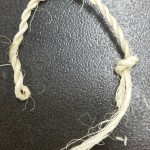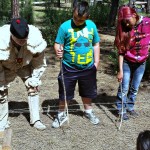Back in Time at the Fur Trade Festival: Part Six

Welcome back!
One of the most exciting activities the students were able to participate in at the Fur Trade Festival was rope making and cording. I know they had a blurb on fire starting with flint in the same session, but I had to walk away as I received a phone call from my daughter-in-law and needed to take the call.
But I did make the demonstration on cording, which I was thrilled about because in my next Young Adult novel, my teen characters have to cord from horsehair in order to survive. When I tried cording with a chunk of tail hair from my husband’s mare, I wasn’t willing to waste my gelding’s tail hair (hers is thicker anyway), I found from this demonstration that I was doing it wrong. No wonder I was unsuccessful at home. I know I had it right in my manuscript, which I did go back and double check, but I just couldn’t get the job done.
But first, fire starting.
As I was walking off to take my phone call, I heard the speaker say the matches Lewis and Clark used were called Lucifers and they would strike them on the side of a box. Sound familiar? But before strikeable matches, a flint piece and knife blade or rock was used to create sparks.
The person making the fire would gather usually 100% cotton or char cloth. They would then strike the flint and sparks ignited the cloth. Dry black moss off pine trees or dry grass is another great source of fiber to start a fire. They would add bits of tinder consisting of pine needles and slivers of wood until the fire was large enough to add twigs and then larger pieces of wood.
The kids got a big kicks out of watching sparks ignite a fire. But they were disappointed none of them could try. Probably best.
Onto Cording.

The students shifted their focus to small pieces of hemp fiber. They were asked to twist half of the hemp segment away from them until it unwound and then rewound in the opposite direction. This would cause the rope to automatically create a loop or eye and from there students could begin to cord.
They would continue to twist the bit of hemp fiber around itself until it formed a rope as the pictures show. It was a thrill for me and pretty darn frustrating for some of the students. I quickly finished my piece and scurried from one student to the next to assist. Finally, everyone had a nice bit of cord and all, well most, were satisfied.
Rope Making.
While researching cording techniques for my work in progress (manuscript), my friend Jan Grueter was able to find the information for me (thank you, ma’am!), I didn’t know the term cording existed as I persistently searched the web for ‘rope making’. I was fascinated with how horsehair rope was made with wooden and mechanical contraptions.

Then when my eyes saw the wooden rope maker sitting on the ground before me, I was even more excited. I would be able to actually see how the wooden ones were used. Six different students were choses, three at a time, to go on the rope walk.
Why was it called rope walk? Because two students carried forked sticks and had to literally walk up and down the length of the rope, making sure the hemp fibers didn’t knot up as a third student turned the lever that twisted the three strands of hemp that formed the rope. They had a big time. Once the rope was made, tied off, and cut into sections, each student received a piece of the rope they or their friends made.
On the way back to the school at the end of the day, I asked the students what their favorite session of the day was, well as you can imagine, many replied the rope walk.
More information on the Fur Trade Festival:
Every year the Lake Roosevelt National Recreation Area’s education specialist, Janice Elvidge, heads up the Fur Trade Festival at the Kettle Falls Historical Center and Mission Point that perches above Lake Roosevelt at Kettle Falls, WA which is a section of the Columbia River from Grand Coulee Dam to the Canadian border.
This year was the fourth annual event for grades 3-6 held June 2, 2014. Sessions this year included: Furs of the Fur Trade, David Thompson and David Douglas at the Kettle Falls, Fur Trade Tools, Traps, Fire and Firearms, Fire Starting and Rope Making, Indian Sign Talk, and Tools and Women of the Fur Trade.
Area schools and their classrooms participate. I think I was the only program coordinator/teacher who brought an after school program––Rez Stop (Raising our Educational Zone and Standing Tall On Pride). So we actually had grades 3-7 represented in one group and the students had an exciting and education time learning about the old days and how people survived and traded.
Next week, which will be the last segment to the Fur Trade Festival, we’ll explore the land with naturalist and author Jack Nisbet just as David Douglas did when he was in the area working with the Natives.
Thank you for stopping by and see you next time!
The Fur Trade Festival is sponsored by:
National Park Service, Lake Roosevelt National Recreation Area, Kettle Falls School District, Friends of Spokane House, Kettle Falls Historical Society

Sure learned a lot in this section! Thanks Carmen
Thank you for stopping by!